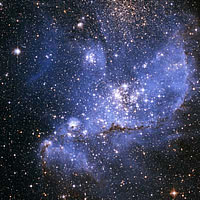UK astronomers to look back 12.8 billion years in time
A team of UK-Australian astronomers is to use a new instrument to look back 12.8 billion years to a time when the first stars were appearing following the Big Bang. The project was announced at a meeting of astronomers at the UK's University of Birmingham, where numerous recent discoveries and forthcoming endeavours have been announced. The 'Dark Age Redshift Lyman Explorer' (DAZLE) has taken the UK-Australian team five years to develop. If successful, it will enable the team to search for the most distant galaxies in the Universe. The stars appearing 12.8 billion years ago were the first to emerge from the gloom that dominated the Universe after the Big Bang. 'DAZLE is a special, highly sensitive, imaging instrument that detects infrared light,' said Richard McMahon from the University of Cambridge. 'It has been designed to search for galaxies that emit no radiation at optical wavelengths but emit light at infra-red wavelengths that are invisible to the human eye.' The instrument will be tested for the first time later this year on the European Southern Observatory's eight metre Very Large Telescope in Chile. Previous attempts to look back this far in time have so far been unsuccessful, so this could be a groundbreaking observation,' said Dr McMahon. 'At this early time in the history of the Universe, a major change occurred in the gas in the Universe,' he explained. After the Big Bang, the Universe expanded and cooled town to a temperature of minus 270 degrees Celsius. At some point, the Earth was heated up again, but opinions differ as to when this happened. DAZLE should be able to provide conclusive evidence on this matter. The detection of light coming from the first stars to form in some of the most distant galaxies seen was also announced at the meeting. UK and US astronomers have used the Spitzer Space Telescope and the Hubble Space Telescope to gather new evidence that the formation of the first galaxies may have got underway earlier than previously thought. The scientists involved believe that the Dark Ages ended sometime between 200 and 500 million years after the Big Bang. UK scientists have also observed massive black holes growing in young, distant galaxies, providing new insights into the construction of today's largest galaxies and their central black holes. The team studied galaxies originally identified by the James Clerk Maxwell submillimetre telescope, and then used NASA's Chandra X-ray Observatory to find strong x-ray glows produced by hot gas swirling around the growing black holes. The black holes were found to be growing at the same time as their galaxies. The black holes were seen to be surrounded by a dense shroud of gas and dust, which is likely to be the material to be consumed by the growing black holes. The growth of galaxies and their black holes is likely to be the result of major mergers involving collisions between two galaxies of similar size, say the astronomers. A computer simulation performed by Tiziana Di Matteo of Carnegie Mellon University in the US has shown that these mergers drive material towards the central regions of galaxies, producing stars and providing the fuel that feeds the black hole and enables it to grow.
Countries
United Kingdom



